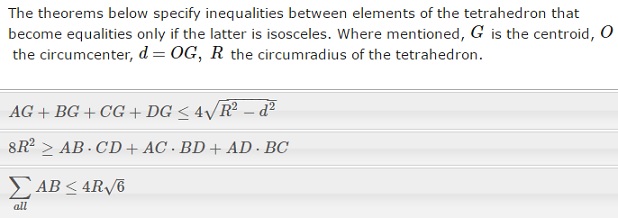Isosceles Tetrahedron
Tetrahedron is isosceles if its opposite edges are pairwise equal. Every tetrahedron is associated with (inscribable into) a parallelepiped. In case of isosceles tetrahedron, the associated parallelepiped is a cuboid, parallelepiped with orthogonal faces and edges. This endows isosceles tetrahedron with many surprising properties.
Tetrahedron with faces of equal perimeters is isosceles.
Tetrahedron with faces of equal areas is isosceles.
This is an especially curious result for which there currently are three essentially different proofs:
- Splitting the faces into pairwise equal triangles
- Proving equality of opposite dihedral angles
- Using relation between planes and orthogonal lines
Tetrahedron in which the centers of the inscribed and the circumscribed spheres coincide is isosceles.
Tetrahedron in which the circumcenter and centroid coincide is isosceles.
Tetrahedron in which the incenter and centroid coincide is isosceles.
Tetrahedron in which three plane (face) angles at each vertex (three suffice) add up to $180^{\circ}$ is isosceles.
Tetrahedron in which common perpendiculars of the opposite edges are pairwise orthogonal is isosceles.
Projections of the edges of an isosceles tetrahedron from its circumcenter onto the circumsphere tile the sphere with equal spherical triangles.
For a point in an isosceles tetrahedron the sum of distances to the faces is constant.
Isosceles tetrahedra can be characteried by equalities in the following inequalities:

|Contact| |Front page| |Contents| |Geometry|
Copyright © 1996-2018 Alexander Bogomolny73606499
